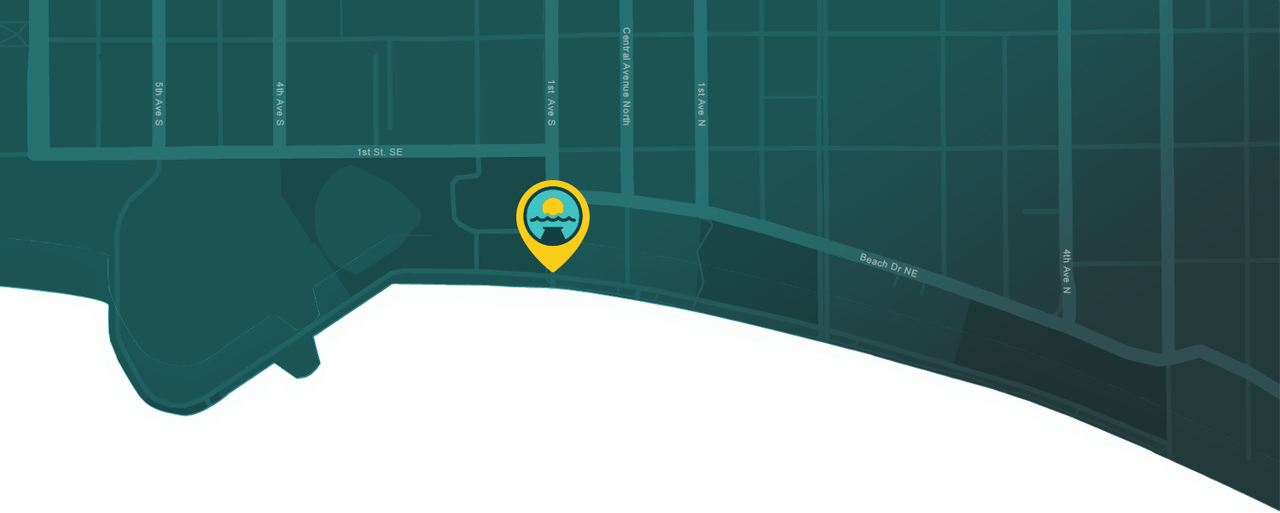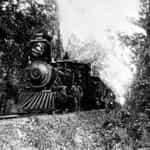
The Orange Belt Railroad built the city’s first pier in 1889 to facilitate the transport of goods between sea-going vessels and trains. It quickly became popular as a recreation destination as well. A bathing pavilion with toboggan slide (front right) was soon added. Photo courtesy of the State Archives of Florida.
The Orange Belt Railroad’s arrival on the Pinellas Peninsula was the result of an enterprising Russian by the name of Pyotr Alexeyevitch Dementyev, who was fleeing repression in his native country. Dementyev, who quickly changed his name to Peter Demens, settled in tiny Longwood, Florida, and became owner of a fledgling railway. Seeking land on the Pinellas Peninsula on which to extend his rail line, he met John C. Williams, a wealthy Detroit native who owned 1600 acres of land in what is now downtown St. Petersburg. With the assistance of his influential wife Sarah, Williams convinced Demens to settle the Orange Belt Railway terminus on his land, at the junction of 9th Street and 1st Avenue South. At the time, the area was occupied by the tiny hamlet of Wardsville, named after the local postmaster.
After a difficult construction period, the Orange Belt’s locomotive Mattie rolled into town on June 8, 1888, with one lone passenger – a shoe salesman from Savannah, who took one look at his dismal prospects and headed home the next day! As part of the agreement with Williams, Demens agreed to build a grand hotel in the budding village as well as a railroad pier that would extend far enough into the Bay to accommodate ships drawing twelve feet of water. Demens named the hotel after William’s home-town of Detroit, a generous concession to the city co-founder after beating him to the punch on the naming of the city – which became St. Petersburg after Demens’ home town. Demens finished the extension of the rail line the following year, building the wooden Railroad Pier 3000 feet into the Bay.

The Detroit Hotel was built in St. Petersburg in 1888, at today’s Central Avenue and 2nd Street North, the result of negotiations between city founders John C. Williams and Peter Demens. City lore describes tension between the two over the naming of the city, with a coin toss finally determining that Demens would name the city after his Russian hometown, while Williams would name the first hotel after his Michigan hometown. The more prosaic truth is that Demens had the more sophisticated business operation and filed the appropriate paperwork to name the city first. Photo courtesy of the State Archives of Florida.
Even after the arrival of the Orange Belt railway, the journey to St. Petersburg was not an easy one. Hasty construction and the vagaries of Florida weather meant that a train arriving on time, or even within several hours of its scheduled arrival time, was a noteworthy occasion. Those passengers that braved the journey would disembark at the passenger depot on today’s 1st Ave South, just a stone’s throw from the Detroit Hotel on Central Avenue. With a depot designed in the same Russian architecture as the Detroit Hotel, a style that reminded Demens of his native country, a visitor could be forgiven for thinking he was arriving in a different St. Petersburg altogether.
Fishing was the lifeblood of the economy in St. Petersburg’s early years. Henry W. Hibbs opened a fish house on the Railroad Pier in 1889, and was quickly processing more than a thousand pounds of fish a day. Local plants provided ice for packing, and soon the fish houses of St. Petersburg were shipping mackerel and snapper to cities up and down the east coast. By the 1890s, St. Petersburg’s fishing trade was producing three million pounds of fish per year. Cottage industries of boat builders, net makers and the like, sprouted along the waterfront.

A crowd in St. Petersburg witnesses the end of an era as the final train departs the downtown station at 1st Ave South in 1963. For more than 75 years, from 1888 to 1963, trains from the Orange Belt, the Atlantic-Coastline, and Seaboard Rail lines serviced the downtown area..Photo courtesy of the State Archives of Florida.
Having limited access to the beaches of the barrier islands, residents soon recognized the pier as a place that could be valuable for more than just industry. Within two years an attractive bathhouse was added for the leisure of residents and visitors. Swimmers mingled with fishermen, and daredevils splashed into the Bay from a toboggan slide – barely noticing the trains passing by just inches away. It seemed the dueling desires of business and pleasure could both be fulfilled at the waterfront, but that symbiosis wouldn’t last.
Changing hands numerous times as railroads were bought and sold, the Railroad Pier was finally torn down in 1952, deemed a menace to navigation in a city whose fortunes had shifted from fishing to tourism.

Warehouses and ice manufacturing facilities line the Railroad Pier in St. Petersburg. The earliest piers in St. Petersburg served dual purposes of catering to the fishing and shipping industries, while also providing recreational opportunities for residents and tourists. Courtesy State Archives of Florida.







